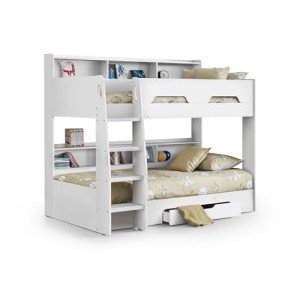Bunk beds have actually long been a staple in kids's bed rooms, providing a mix of space-saving efficiency and fun. Whether accommodating brother or sisters, friends on slumber parties, or simply making the most of a playroom, bunk beds have ended up being an essential aspect in modern household homes. As sales on bunk beds increase, it becomes increasingly essential for customers to make educated choices when acquiring one. This post will cover the fundamentals of acquiring a bunk bed, from types to safety features, as well as suggestions for maintaining the integrity of your investment.
When considering a bunk bed sale (click the following page), it's crucial to comprehend the various designs readily available on the marketplace. Below are the most common types:
Traditional Bunk Beds: These include 2 beds stacked one above the other, sharing a single frame. They are typically the most affordable alternative.
L-Shaped Bunk Beds: This design includes one bed positioned vertically and another horizontally. This plan develops extra space underneath the upper bed, which can be used for storage or a play area.
Lofted Beds: Similar to standard bunk beds but with no lower bed. Instead, the space below can be utilized for a desk, play area, or additional storage.
Triple Bunk Beds: For families with a bigger number of children or regular slumber parties, triple bunk beds offer 3 sleeping locations in a space-efficient design.
Futon Bunk Beds: These styles combine bunk beds and futon couches. The bottom area transforms into a separate seating area, enhancing performance.
Convertible Bunk Beds: These beds can be separated into two individual beds, making them flexible as children's requirements alter in time.
| Type | Description | Space Efficiency | Additional Features |
|---|---|---|---|
| Conventional Bunk Bed | 2 beds stacked vertically | High | Most basic design |
| L-Shaped Bunk Bed | One vertical and one horizontal bed | Moderate | Play or storage space |
| Lofted Bed | Raised bed with open space listed below | High | Work/play location |
| Triple Bunk Bed | Three stacked beds | Really High | Accommodates more users |
| Futon Bunk Bed | Bunk bed with a convertible futon | High | Multi-functional |
| Convertible Bunk Bed | Can be divided into 2 different beds | Moderate | Flexibility & & durability |
Security is paramount when buying a bunk bed. Below are key safety functions to search for:
Guardrails: Adequate guardrails ought to exist on both sides of the upper bunk to avoid falls. They must be at least 5 inches higher than the mattress.
Ladder Design: Look for tough, broad ladders with slip-resistant rungs. Ensure that the angle is not too high for easy gain access to.
Stability: Ensure the bed is built with strong products, such as strong wood or sturdy metal. The bed should not wobble when in use.

Weight Limit: Check the weight capacity of the bunk bed to guarantee it can accommodate the designated users securely.
Product Safety: If possible, select beds made from non-toxic materials or those fulfilling security requirements for kids's furniture.

| Function | Description | Value |
|---|---|---|
| Guardrails | Sides of upper bed to avoid falls | Necessary for kid safety |
| Ladder Design | Strong, slip-resistant rungs | Help safe and simple gain access to |
| Stability | Develop quality to prevent wobbling | Makes sure security and longevity |
| Weight Limit | Optimum weight capability | Avoids mishaps |
| Material Safety | Non-toxic, safe materials | Secures kids's health |
To extend the life of your bunk bed and ensure ongoing security, think about the following upkeep ideas:
Regular Inspections: Periodically inspect the structure for loose screws, bolts, or any signs of wear. Tighten fasteners as needed.
Tidy Periodically: Dust and tidy the surfaces routinely. Usage appropriate cleaners that won't damage the surface.
Check Weight Limits: Be conscious of weight limitations, especially with older children or adults who might want to use the upper bunk.
Prevent Climbing on Guardrails: Educate kids not to utilize guardrails for climbing or playing to decrease the danger of mishaps.
Q1: What is the age limitation for kids to safely use bunk beds?A: While it varies by the maker, many recommend that children under six must not sleep in the upper bunk due to safety concerns.
Q2: How can parents prevent risky climbing?A: Setting clear rules about bunk bed usage and supervising children can help. Additionally, utilizing a bed tent can dissuade climbing up while producing an enjoyable sleep environment.
Q3: What should I think about when decorating a space with bunk beds?A: Ensure there suffices space around the bunk bed for safe movement, and utilize the decoration to produce customized areas for each child.
Q4: Is a lofted bed suitable for older children?A: Yes, lofted beds can be ideal for older kids as long as they satisfy safety requirements and the child is responsible enough to utilize them safely.
Bunk beds serve a practical purpose while including a component of fun to a child's bedroom. As sales of bunk beds continue to rise, cautious consideration of types, safety functions, and maintenance practices is vital for moms and dads and caretakers. By comprehending these crucial factors, households can find the perfect bunk bed for their home, guaranteeing both usefulness and security for many years to come. Whether it's for brother or sisters sharing a room or creating a cozy slumber party space, a well-chosen bunk bed can provide delight and functionality, making it a worthy investment.